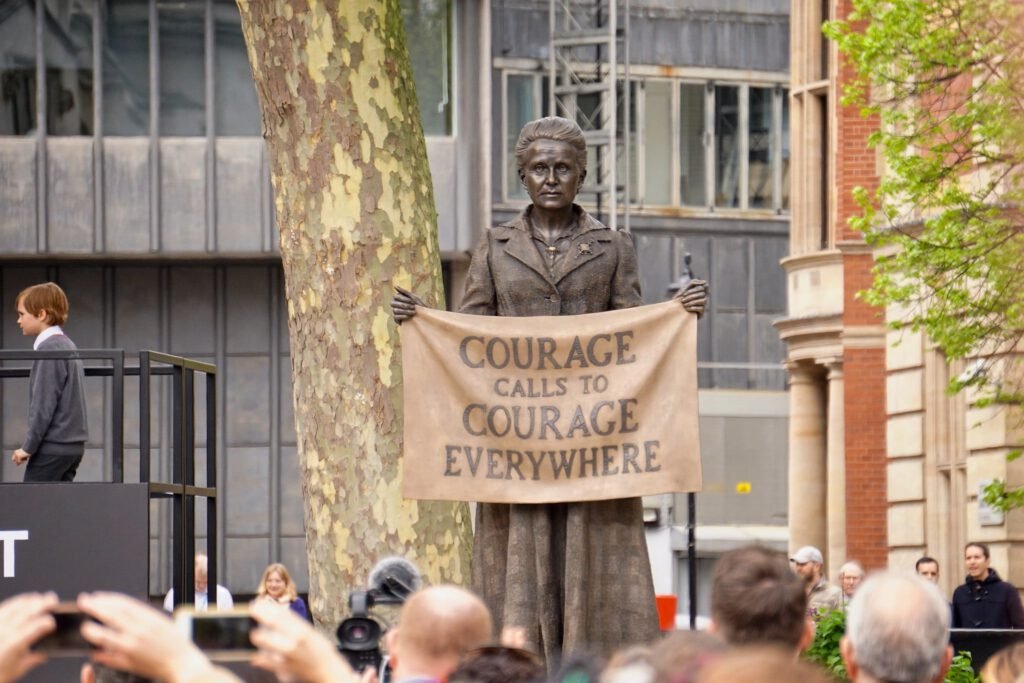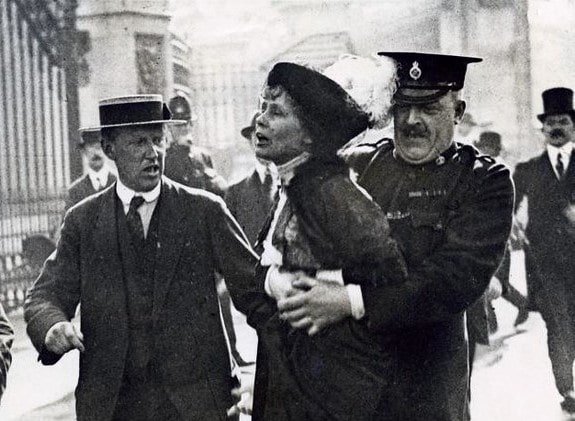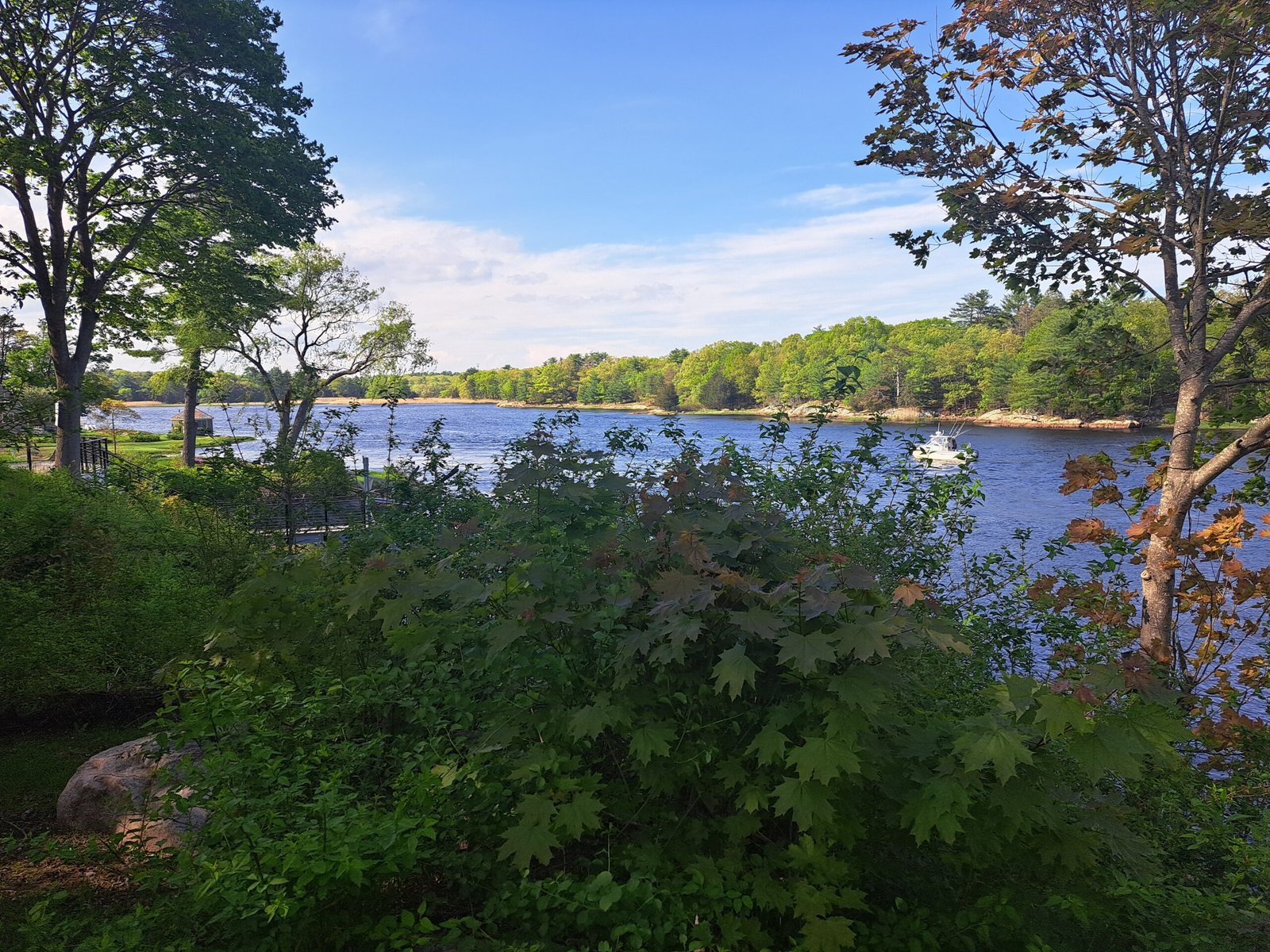The women’s suffrage movement in the UK encompassed many individuals and organisations with differing views and strategies. What can we learn from this?
The story of the struggle for the enfranchisement of women in the UK is widely regarded as the story of the Suffragettes. This narrow focus, however, belies the diversity of work and strategies that underpinned the women’s movement in the late 19th and early 20th centuries. A common aim does not equal a common strategy in either the past or present.
Barbara Bodichon and a group of friends met regularly throughout the 1850s at Langham Place in London to discuss women’s rights, making “The Ladies of Langham Place” one of the first organised women’s movements in Britain. Bodichon’s Brief Summary of the Laws of England concerning Women1 was valuable in furthering the development of the Married Women’s Property Acts. “At last, the stark facts were there for all to see. The position of married women, in particular, was a cause for grave concern.”2 Individual cases had also had some impact on the legal position of women, for example that of Caroline Norton, whose writings regarding the custody laws which allowed her abusive husband to prevent her seeing their children, helped to pass the 1839 Custody of Infants Act and influenced the contents of the 1857 Marriage and Divorce Bill. Bodichon did not have the universal support of women in her attempts to improve their legal position, novelist Margaret Oliphant declaring it “the merest nonsense.”3 Bodichon instigated the move for women’s suffrage that resulted in John Stuart Mill’s attempt to amend the Second Reform Bill in 1867 by replacing the word ‘man’ with ‘person’. Whilst Bodichon’s work did not succeed in gaining women’s suffrage, she was instrumental in the development of women’s rights, Sybil Oldfield opining that she had a “genius for setting important, necessary changes in the lives of women in motion.”4
Bodichon’s influence can be seen in the person of Lydia Becker. Bodichon’s paper Reasons for the Enfranchisement of Women was read at the annual meeting of the National Association for the Advancement of Social Science in the autumn of 1866, where it caught the attention of Becker – who went on to form the Manchester Women’s Suffrage Committee in January 1867, the first organisation of its kind in England, and in November of the same year the National Society for Women’s Suffrage. “The history of the decades from 1860 to 1890 – so far as women’s suffrage is concerned – is the history of Miss Becker,”6 a proposal by William Forsyth MP in 1874 that he would be willing to promote a bill that would grant the vote to unmarried women only. This split the suffrage movement, “dividing [Becker] from the Brights, Pankhurst and Elizabeth Wolstenhome Elmy”7. However it was also Becker who organised and spoke at an 1874 event in Manchester, where Emmeline Pankhurst experienced her first public women’s suffrage meeting aged just 15 – arguably inspiring Pankhurst’s pursuit of women’s rights and therefore justifying the reference to Becker as the “forgotten face”8 of the suffrage movement. Councillor Margaret Riley says Becker “kept the flame alive when interest waned;”9 however there is much debate as to who organised the meetings that kept the suffrage movement alive in the 1880s. Sandra Holton argues “persuasively that the demonstrations emanated from the Radical Liberal wing of the women’s movement, from the Brights and the McLarens, and were originally to be held in spite of the opposition of Lydia Becker.”10 Whatever the truth, Becker was a leading speaker at 8 of the 9 events attracting “capacity crowds and enormous publicity”11, so it is impossible to deny her influence.

The National Union of Women’s Suffrage Societies, or the Suffragists, which formed out of numerous existing women’s suffrage groups in 1897, took a non-confrontational approach to furthering women’s rights. They raised their profile peacefully with posters, leaflets and meetings – taking the view that through argument and education they would eventually succeed in achieving their aims. Marlow insists “it was the moderates of the NUWSS…who actually won the vote”12 in particular helped by their alliance with the Labour Party. Millicent Fawcett decided to seek a union with Labour as they had continually supported female emancipation, whilst the Liberal leaders had been divided on the issue and failed to assist the cause. Fawcett and the NUWSS formed the Election Fighting Fund committee (EFF) with the sole purpose of penalising Liberals whilst raising money to support Labour candidates13. The EFF caused splits within the movement: “major societies in Glasgow, Cardiff and Oldham opposed the new strategy, suggesting it was unlikely to be effective in the short-term and would be counter-productive by deterring Liberals from sharing suffrage platforms.”14 By 1914 the EFF had failed to secure a single victory.15 The policy was also to prove counter-productive during the war.16 By 1914, women’s suffrage had not been achieved, although it would be partially granted at the end of the war. Perhaps for too long the importance of the NUWSS has been underestimated,17 In complete contrast to the Suffragettes, the NUWSS concentrated on activities in Parliament and have therefore been criticised for having “sacrificed opportunities to mobilise mass support throughout the rest of the country.”18 It is clear that the NUWSS played an important role in keeping the issue of women’s suffrage alive in the minds of parliamentarians, if not the public, but Fawcett herself acknowledged in 1906 that Emmeline Pankhurst had helped the movement “more during the last twelve months…then we have been able to accomplish in the same number of years.”19
In 1903, the WSPU was formed. The Suffragettes, unlike the Suffragists, were quick to attract public attention when Annie Kenney – the only working class woman to join the senior ranks of the WSPU (becoming Deputy in 1912) – and Christabel Pankhurst heckled Sir Edward Grey at a Manchester Liberal rally and subsequently spent several days in prison for assault and obstruction. This incident, in October 1905, is recognised as instigating the use of militant tactics in the female suffrage movement. The nature of their actions forced people to take notice, Constance Rover arguing that the “militants kept the movement in the public eye and much of the credit must be given to them.”20 Attempts to control suffragette activists with harsh prison treatment only won public sympathy, and the press were swift to plaster their names, faces and efforts across the front pages. For example, Emily Wilding Davison, who was imprisoned on nine separate occasions and force-fed forty-nine times, was held up as a martyr when her coffin was met by thousands as it journeyed through London after she stepped in front of King George V’s horse on 4th June 1913 and was killed.
However, whether Davison’s act was positive or negative for the cause has been the cause of much debate – Pugh labelling her, “the good terrorist”21. Firstly, it cannot be known that Davison actually intended to commit suicide given that supposed eye witness, suffragette Mary Richardson, who claimed Davison “knew that death was galloping towards her”22 is now generally accepted as not actually having been at Epsom, and Davison possessed a return ticket. What is significant about this is the variety of public reactions to Davison’s demise: many directed their anger over the death of the King’s horse (taken as a direct insult to the King) at the Suffragettes; and there was also increased hostility and often violence towards Suffragettes, even from non-militant Suffragists – not necessarily as a result of this event, but this would certainly have contributed. Pankhurst and the Suffragette leaders attempted to work Davison’s death in their favour by emphasising the heroic nature of her actions, which to some extent seemed to work; Pugh describes the “spectacle of her funeral as a very moving one”23 at which the crowds “took off their hats as a sign of respect at the mention of [Davison’s] name”24. However, the negative connotations which grew out of such a public act of violence – referred to as a form of terrorism in The Daily Sketch’s front page article the following day – could not be quashed so easily. Davison’s “mad act”25, seemingly on behalf of the WSPU, did nothing to alter government response to the Suffragettes, with raids, interception of mail and telephone calls, and seizure of newspapers continuing with little public protest, as such militancy and violence appeared to isolate the movement from the public. Sometimes it seemed that independent acts fuelled the movement; for example, prison hunger strikes and boycotting of the 1911 Census were suggestions by ordinary suffragette supporters which came to be accepted by the Pankhursts due to their popularity, but in reality Pankhurst kept a tight rein on the movement, one suffragette opining “Emmeline Pankhurst wishes women to have votes [but] she will not allow them to have opinions.”26 Pugh goes so far as to state that the exodus of women from the WSPU to the NUWSS was “the one constructive contribution of…Pankhurst’s to winning the vote,”27 whilst some women at the time claimed that the “shrieking sisterhood,”28 alienated many like her who were keen supporters of women’s rights. Perhaps June Purvis best sums up Pankhurst: “gentle and fiery, idealistic and realistic, creative and destructive, kind and ruthless, democratic and autocratic, invincible and vulnerable, courageous and afraid.”29 Pankhurst both inspired and repulsed, but she certainly attracted attention.
The outbreak of the First World War saw both the WSPU and NUWSS alter their strategies. As mentioned previously, many members of the NUWSS campaigned for peace to be restored, but were urged to support their country by Fawcett who understood that any peace campaign would be interpreted as proof women could not be trusted with the vote due to their pacifism. Similarly, Pankhurst called an end to suffragette militancy and urged women to take on ‘male jobs’ for the sake of the war effort, publishing the following slogan in The Suffragette: “a thousand times more the duty of the militant Suffragettes to fight the Kaiser for the sake of liberty than it was to fight anti-Suffrage Governments”.30 The opportunity to undertake traditionally male roles was incredibly beneficial to women and their position in that it “liberated them from social restrictions and moral boundaries,”31 according to Taylor. Bourke supports this view that war was an important factor in changing the way in which women were viewed in society, given that it “hastened the collapse of traditional women’s employment, particularly domestic service”.32 Fawcett herself certainly agreed, saying that “the war revolutionised the industrial position of women – it found them serfs and left them free.”33 It is also true that the general opinion of women seemed to drastically change as a result of World War One; Rover suggests that “public opinion became overwhelmingly favourable towards women”.34 Therefore, it could have been that women’s contribution to the war effort was the direct cause of the 1918 Representation of the People Act, which gave the vote to women over the age of thirty who held property. Several additional pieces of post-war legislation, including the 1919 Sex Discrimination Removal Act and the 1922 Law of Property Act (meaning spouses could inherit each other’s property), coupled with the election of the first female MP – Constance Markiwicz – in 1919, also point towards the idea that the war was indeed the reason for female emancipation. However, Bruley argues that despite the respect for women’s contributions, “the notion that motherhood was women’s primary role was never challenged.” 35 To suggest the vote was granted as a reward for war work is dismissive of the impact of the Suffrage movement before the war. This is supported by the fact that French women engaged in the war effort to the same extent as British women but were not granted the vote – perhaps because there had been very little to show for any emerging French suffrage movement prior to WW1. Fulford has suggested that the Government utilised their appreciation for women’s efforts during the war to disguise their giving in to the militancy of the Suffragettes by presenting the vote as a reward for war work, and that the “conventions of the Victorians” 36 were in fact “slowly dissolving long before… 1914”.37 Similarly, Bartley states that “It would be naïve to believe that women received the vote solely for services rendered in the First World War”.38
What can women engaged in the struggle for women’s rights in the 21st Century learn from the divisions, failures, and successes of the women’s suffrage movement? Ultimately, we need all sorts of women. We need those who write academic articles, we need those who perform attention-grabbing activities. We need those who lobby politicians, we need those who sign petitions. We need those who pursue legal challenges, and we need those who donate to causes and organisations. We need those who quietly influence others through conversations and activism, we need those who highlight and shine a light on the influence of pressure groups who aim to roll back women’s rights.

- Published 1854.
- Candida Ann Lacey, Barbara Leigh Smith Bodichon and the Langham Place Group, 2013, Page 4.
- Lacey, Page 5
- Sybil Oldfield, ‘Thinking Against the Current’: Literature and Political Resistance, Sussex Academic Press, 2015
- Roger Fulford, Votes for Women: The Story of a Struggle/efn_note] says Fulford. In April 1868 Becker stated at the first meeting of the National Society for Women’s Suffrage that women should be granted voting rights on the same terms as men, before beginning a lecture tour of northern England. It was Becker and the National Society for Women’s Suffrage who managed to secure the vote for women in municipal elections in June 1869. However, in 1872 married women were excluded as they had no legal identity separate to their husbands, and in 1880 it was ruled that this meant women could not stand for election. Becker was criticised for supporting, for “political expediency”, 5Elizabeth Crawford, The Women’s Suffrage Movement: A Reference Guide 1866-1928, 2003, Page 45
- Crawford, Page 45
- http://www.archivesplus.org/history/lydia-becker-and-the-manchester-suffragists/
- Oldham councillor Margaret Riley, 1999, at a ceremony where a plaque was unveiled at Becker’s family home, quoted in the following article http://aboutmanchester.co.uk/featured/wo-manchester-lydia-becker/
- Crawford, Page 46
- Linda Walker, ‘Becker, Lydia Ernestine (1827–1890)’, 2004
- Joyce Marlow, Votes for Women
- Mitzi Auchterlonie, Conservative Suffragists: The Women’s Vote and the Tory Party, Page 182
- Martin Pugh, The March of the Women: A Revisionist Analysis of the Campaign for Women’s Suffrage 1866-1914, 2000, Page 270
- Pugh, Page 277
- The policy was abandoned at the outbreak of war so that should a wartime general election be held, the Suffragists would be free to support the government – Labour traditionally being seen as pacifist and unpatriotic by many. This decision was crucial if the female suffrage movement were to see any success as the association of the suffragists with the peace movement would be detrimental to any idea that women may be trusted with the vote. This is demonstrated clearly by a meeting on 4th August 1914 which, despite Millicent Fawcett’s (potentially calculated) display of patriotism as she “urged the women to recognise their duty to support their country in the crisis”, was portrayed by the press as evidence of a women’s peace movement as it had initially been advertised as a peace rally. The meeting succeeded only in “reviv[ing] male fears that women could not be trusted with the vote as they would be pacifists,” even causing Lord Robert Cecil of the Conservative Party – one of the most important supporters of female suffrage – to doubt “the fitness of women to deal with great Imperial questions (Kent, 1993: 76).” The war led to a split in the society between those who believed their goal was to “establish the supremacy of reason over physical force,” and therefore opposed the war and those who believed – and rightly so – that links to the peace movement would render them vulnerable to accusations of disloyalty.
- Harold L. Smith, The British Women’s Suffrage Campaign 1866-1928: Revised 2nd Edition, 2014, Page 21
- http://www.parliament.uk/about/livingheritage/transformingsociety/electionsvoting/womenvote/overview/earlysuffragist/
- The Times, 27th October 1906
- Constance Rover, Women’s Suffrage and Party Politics, 1967
- Martin Pugh, Emily Wilding Davison: The Good Terrorist, History Today Volume 63 Issue 6, June 2013
- Mary Richardson, Laugh a Defiance, 1953
- Martin Pugh, The March of the Women: A Revisionist Analysis of the Campaign for Women’s Suffrage, 1866-1914, 2000, Page 204
- Martin Pugh, The March of the Women: A Revisionist Analysis of the Campaign for Women’s Suffrage, 1866-1914, 2000, Page 204
- Morning Post headline, 5th June 1913
- Paula Bartley, Votes for Women 1860 – 1928, 2007, Page 36
- Martin Pugh, The March of the Women: A Revisionist Analysis of the Campaign for Women’s Suffrage 1866-1914, 2000, Page 279
- Jane Robinson, Bluestockings, 2009, Page 70
- June Purvis, Emmeline Pankhurst: A Biography, 2003, Page 7
- The Suffragette, 16th April 1915.
- Eric Taylor, Women Who Went to War
- Professor Joanna Bourke, Women on the Home Front in World War One
- Millicent Fawcett, 1918, quoted in Bourke’s ‘Women on the Home Front in World War One’.
- Constance Rover, Women’s Suffrage and Party Politics in Britain 1866–1914
- Sue Bruely, Women in Britain since 1900, Page 22
- Roger Fulford, Votes for Women.
- Roger Fulford, Votes for Women
- Paula Bartley, Votes for Women 1860-1928, Page 99








Posted by Jessica Evans
11 June, 2020 at 3:33 pm
Great article - so important to remember that diversity of tactics is what makes a powerful movement. Thanks.